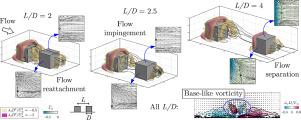Three-dimensional mean flow field around two cubes in tandem
IF 2.6
3区 工程技术
Q2 ENGINEERING, MECHANICAL
International Journal of Heat and Fluid Flow
Pub Date : 2025-07-15
DOI:10.1016/j.ijheatfluidflow.2025.109966
引用次数: 0
Abstract
The mean flow field around two surface-mounted cubes in tandem was investigated through large-eddy simulations at a Reynolds number of Re and with a turbulent boundary layer of thickness at the location of the upstream cube. Center-to-center spacing ratios of , 2.5 and 4 were considered to describe the intermittent reattachment, cavity-locked and synchronized shedding regimes, respectively. The mean flow features were related to the near-surface flow field of the cubes and their drag and normal force coefficients. Although an arch vortex was always present behind the upstream cube, the flow in the gap changed significantly depending on the different flow regimes, affecting the shape, size and strength of the arch vortex. The flow field surrounding the upstream cube did not change significantly with , presenting a similar near-surface flow field to an isolated cube. The near-surface flow for the downstream cube changed from a reattachment pattern for , to impingement for , to flow separation from the leading edges and the appearance of a second horseshoe vortex for . The arch vortex of the downstream cube was uniquely shaped and similar for all , due to flow separation from the cube’s rear edges. Base-like streamwise vorticity regions were present in the downstream cube’s wake, which suggest they may be the time-averaged signature of the vortices shed from the cube.

串联两个立方体周围的三维平均流场
在雷诺数Re =1×104、上游立方体位置湍流边界层厚度δ/D=0.8条件下,通过大涡模拟研究了两个表面安装立方体串联周围的平均流场。中心间距比L/D=2、2.5和4分别被认为描述了间歇性再附着、空腔锁定和同步脱落机制。平均流动特征与立方体的近表面流场及其阻力和法向力系数有关。虽然在上游立方体的后面总是存在拱形涡,但在不同的流动形式下,间隙内的流动发生了显著的变化,影响了拱形涡的形状、大小和强度。上游立方体周围的流场随L/D变化不明显,呈现出与孤立立方体相似的近地表流场。当L/D=2时,下游立方体近地表流动由再附着型转变为碰撞型,当L/D=4时,流动从前缘分离并出现第二次马蹄涡。由于流动从立方体的后边缘分离,下游立方体的拱形涡具有独特的形状,并且对于所有L/D都是相似的。在立方体的下游尾迹中出现了类似基底的流向涡度区,这表明它们可能是立方体脱落的涡的时间平均特征。
本文章由计算机程序翻译,如有差异,请以英文原文为准。
求助全文
约1分钟内获得全文
求助全文
来源期刊

International Journal of Heat and Fluid Flow
工程技术-工程:机械
CiteScore
5.00
自引率
7.70%
发文量
131
审稿时长
33 days
期刊介绍:
The International Journal of Heat and Fluid Flow welcomes high-quality original contributions on experimental, computational, and physical aspects of convective heat transfer and fluid dynamics relevant to engineering or the environment, including multiphase and microscale flows.
Papers reporting the application of these disciplines to design and development, with emphasis on new technological fields, are also welcomed. Some of these new fields include microscale electronic and mechanical systems; medical and biological systems; and thermal and flow control in both the internal and external environment.
 求助内容:
求助内容: 应助结果提醒方式:
应助结果提醒方式:


